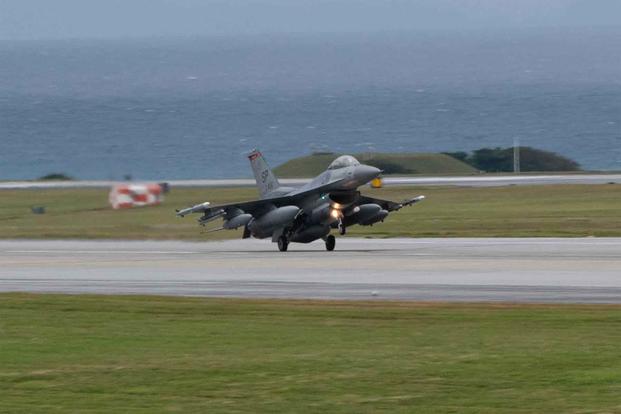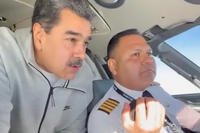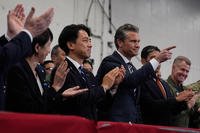The Air Force is temporarily moving fighter jets from Germany to Okinawa, Japan, after the Pentagon announced it was pulling older F-15 Eagles from Kadena Air Base in an attempt to bring more modern aircraft to the Pacific.
F-16 Fighting Falcons from the 52nd Fighter Wing at Spangdahlem Air Base, Germany, arrived at Kadena on Monday, even as the installation continues to slowly return its fleet of F-15C/D fighters to the United States.
The decision to move the fighter jets out of Europe comes as Russia's war in Ukraine continues.
Read Next: Air Force Returns Land Used for Apollo Program to State of Hawaii
David Ochmanek, a senior international and defense researcher at the nonprofit Rand Corp., told Military.com in an interview Tuesday that moving the F-16s out of Germany shouldn’t meaningfully diminish the Air Force's presence around Ukraine.
"Although F-16s are going from Europe to Kadena, it doesn't mean there will be less U.S. combat airpower deployed in Europe," Ochmanek said. "The Air Force has been rotationally deploying squadrons to Europe since the outbreak of war in Ukraine, and I think that's likely to continue for quite some time."
Last week in a meeting with Japan's ministers for foreign affairs and defense, the Pentagon and State Department announced a renewed alliance with the country; the U.S. and Japanese officials also reiterated their fears about China's military expansion in the Pacific.
Those announcements didn’t include a specific change to U.S. forces stationed in Japan, and Monday’s announcement from the Air Force described the repositioning as part of the Pentagon’s broader Asia strategy.
"As the F-16s begin operations, they too will integrate their unique strengths to help Team Kadena deter and, if necessary, prevail over acts of aggression that threaten peace and stability in the Indo-Pacific," the Air Force said Monday in a press release.
There have been notable recent provocations by China. On Dec. 21, U.S. Indo-Pacific Command issued a statement admonishing a Chinese fighter jet's "unsafe maneuver during an intercept" of an Air Force RC-135 Combat Sent aircraft in international airspace.
In August, China launched missile strikes near Taiwan during a military exercise shortly after a visit by then-House Speaker Nancy Pelosi.
"The Ministers concurred that China's foreign policy seeks to reshape the international order to its benefit and to employ China's growing political, economic, military, and technological power to that end," the Pentagon said in a statement after last week's meeting. "This behavior is of serious concern to the Alliance and the entire international community, and represents the greatest strategic challenge in the Indo-Pacific region and beyond."
Republican lawmakers publicly blasted the Pentagon's decision to replace the permanent F-15 fleets in Japan with rotational aircraft, namely F-16 and F-22 fighters sent for limited duration deployments, arguing it was not a wise move as tensions rise with China.
In November, Republican lawmakers -- led by Sen. Marco Rubio of Florida -- asked the Pentagon to provide a briefing "articulating specific steps to replace the deterrent value and combat capability of any assets removed from the Indo-Pacific region, as well as the administration's plan to establish a force posture in the Indo-Pacific that would be resilient to a [Chinese] attack and capable of deterring an invasion of Taiwan."
That same month, F-22 Raptors assigned to the 3rd Wing at Joint Base Elmendorf-Richardson, Alaska, were moved to Japan shortly after Kadena announced it was removing its fleet of F-15s, many of which are upward of 30 years old.
"Modernizing our capabilities in the Indo-Pacific theater remains a top priority for the U.S.," the base said in an October press release. "This transition to more capable aircraft at Kadena exemplifies our continued commitment to enhancing our posture and building on the strong foundation of our Alliance with Japan."
Ochmanek told Military.com that the F-16s and F-22s are a "net gain in modernization" for Kadena. But he said arguments over which type of manned aircraft to send to the base ignore some of the larger problems, such as defending installations in Japan from Chinese missile attacks.
"Whether you've got an F-16 or F-15 or F-22 sitting at Kadena, they're all vulnerable to attack by Chinese missiles," Ochmanek said. "Arguments about the details of what manned aircraft are where, to me, are less interesting than how they're going to evolve the overall posture not just to Kadena but in the region."
The 52nd Fighter Wing did not detail how many F-16s were moved from Germany to Japan.
"We are excited to be here supporting our allies and partners in the Indo-Pacific region," Lt. Col. Shaun Loomis, 480th Expeditionary Fighter Squadron commander, said in Monday's press release. "We look forward to training and operating in this uniquely complex and strategically vital region."
-- Thomas Novelly can be reached at thomas.novelly@military.com. Follow him on Twitter @TomNovelly.
Related: GOP Lawmakers Sound Alarm over Pulling F-15s from Japan














